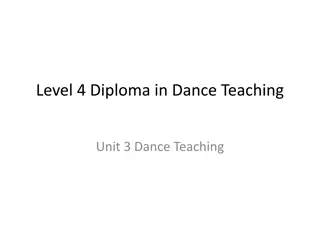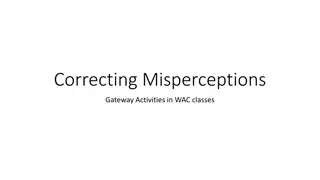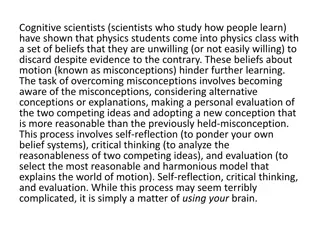Addressing Misconceptions in Teaching and Learning
Explore how misconceptions about learning impact teaching effectiveness and student performance. Learn how cognitive research can enhance teaching methods. Discover the importance of accurate knowledge for effective teaching. Identify common beliefs that hinder teaching effectiveness and student learning.
Download Presentation

Please find below an Image/Link to download the presentation.
The content on the website is provided AS IS for your information and personal use only. It may not be sold, licensed, or shared on other websites without obtaining consent from the author.If you encounter any issues during the download, it is possible that the publisher has removed the file from their server.
You are allowed to download the files provided on this website for personal or commercial use, subject to the condition that they are used lawfully. All files are the property of their respective owners.
The content on the website is provided AS IS for your information and personal use only. It may not be sold, licensed, or shared on other websites without obtaining consent from the author.
E N D
Presentation Transcript
Improving Student Learning by Addressing Student and Teacher Misconceptions about How People Learn Stephen L. Chew Department of Psychology Samford University Birmingham, Alabama slchew@samford.edu Indiana State University March 13, 2012
Goals of the Presentation Discuss misconceptions about how people learn can undermine both teaching effectiveness and student performance Demonstrate how cognitive research can improve teaching and learning Provide you with accurate and practical information for improving teaching and learning from cognitive research Explain the complexities of effective teaching and learning
Three Kinds of Knowledge for Effective Teaching Knowledge of Your Field Effective Teaching Knowledge Of How People Learn Knowledge of How People Learn Your Field
Beliefs about How People Learn Teaching requires a mental model of how people learn. Most teachers cannot articulate their model of learning, but they have one. Determines which teaching methods are selected, how they are implemented and assessed, and how to adjust if there are problems. If the model is accurate, the teacher will be effective If it is flawed or simplistic, the teacher will be less effective
Beliefs about How People Learn Students also base their study behavior based on their models of how people (specifically themselves) learn. Determines whether or not they go to class, if and how well complete assignments, how they study material, and when material is mastered. The better the model, the better the student learns If the model is flawed or simplistic, it will undermine student learning
Some Teacher Beliefs that are Related to Poor Teaching Effectiveness I teach, but it isn t my responsibility whether students learn I teach this way because my integrity prevents me from watering down the material Students won t appreciate my teaching until later My teaching is good enough; there is no need to improve Good teachers are born, not made Teaching well only requires a good knowledge of the material
Beliefs about Learning that Make You Stupid Learning is fast Being good at a subject is a matter of inborn talent rather than hard work, Knowledge is composed of isolated facts I m really good at multi-tasking, especially during class or studying
A Demonstration of Multi-tasking Countdown from 10 to 0 out loud as quickly as you can Say the letter of the alphabet from A to K out loud as quickly as you can Now alternate the two: Start with 10 A, and countdown with numbers and up with letters, out loud as fast as you can.
When I Began Teaching I Believed: Even at its best, teaching is no more than an invitation to learn Whether students learn is not up to me Teaching quality is measured in terms of how current the information is, the accuracy of the information and how clearly it is explained. The measure of a good test is that it yields a good spread of scores. Rigorous teachers give hard assignments and hard exams, and that s the best way for students to learn. Really effective teachers get bad evaluations. It means that students had to work hard and learn. Teachers who get high evaluations are probably more popular than good.
Consequences of Traditional Model of Teaching and Learning Lack of helpful advice to struggling students Study harder and study longer You are stupid and lazy Teaching is still fad driven Teaching methods change, but teaching does not advance Lack of a framework to help teachers improve You can t fix a component of teaching that you don t know exists
Enlightened Beliefs about Teaching and Learning Passive learning, like lecture and note taking is bad; active learning, like collaboration and discussion, is good. The teacher as expert is bad; the teacher as facilitator is good. Sage on the stage vs. the Guide from the side Multiple choice exams test facts and are easy; essays test understanding and are hard. Teaching quality is determined by the methods you use (collaborative, active, interactive, etc.) I use PBL, or clickers, or service learning, so I must be effective
Teaching vs. Learning These beliefs about teaching are based on what the teacher does, and not what the student learns. Student learning is the sole criterion of effective teaching What is your evidence of student learning? Teaching becomes a problem in applied psychology As complex as any research problem Mastering teaching takes a lifetime, and there is always more to learn The scholarship of teaching and learning
Put another way If teaching is nothing more than explaining material well, then it is easy and most anyone can learn to do it. If teaching is about developing student understanding, then teaching is challenging and you will spend your entire career mastering it.
So how accurate are your beliefs about how people learn?
Which of the following is the MOST important ingredient for successful learning? 1. The intention and desire to learn 2. Paying close attention to the material as you study 3. Learning in a way that matches your personal Learning Style? 4. The time you spend studying 5. What you think about while studying
Read the instructions for the demonstration to yourselves and do your best to follow them.
Levels of Processing Shallow processing focuses on spelling, appearance and sound. Rote memorization of facts Flashcards Deep processing focuses on subjective meaning. Relating new information to prior knowledge Making information personally meaningful
Rate each word Do you find the word Pleasant? Does the word contain an E or G? Deep processing: You are relating the words to your own meaningful experiences. Shallow processing: You are focusing on spelling. These are orienting tasks that cause you to think in deep or shallow ways, regardless of your intention
Four different conditions Be forewarned you will be asked to recall all the words Front Left Right Shallow Warned about Recall Deep Warned about Recall Deep Not Warned Shallow Not Warned
Study Conditions 1. If motivation to learn matters, the front tables should recall best 3. If both deep processing and motivation matter, the front right should recall best Front Right Left Shallow Warned about Recall Deep Warned about Recall 2. If deep processing matters, The two right sections should recall best Deep Not Warned Shallow Not Warned
Intention vs. Level of Processing Intentional Incidental 80 69 68 70 67 60 50 43 % Recall 39 40 30 20 10 0 Shallow: E Checking Deep: Pleasantness Level of Procssing Control
Which of the following is the MOST important ingredient for successful learning? 1. The intention and desire to learn 2. Paying close attention to the material as you study 3. Learning in a way that matches your personal Learning Style? 4. The time you spend studying 5. What you think about while studying
Learning Strategies Intention and motivation to learn are not important Attention and amount of study is necessary, but not sufficient for learning Deep level of processing is critical for learning elaborative, distinctive, personal, appropriate Students have highly practiced poor learning strategies Consider your learning activities in terms of level of processing Assignments, problem sets, questions, examples Studying, note taking, reading, writing, listening
These findings are strongly counterintuitive The more students study, the more they learn All study is effective, only amount and intensity matter Motivation automatically improves study effectiveness Learning is hard work, but not all hard work leads to learning
Achieving Deep Processing while Studying As you study, follow these principles: Elaboration: How does this concept relate to other concepts? Distinctiveness: How is this concept different from other concepts? Personal: How can I relate this information to my personal experience? Appropriate to Retrieval and Application: How am I expected to use or apply this concept? These properties lead to development of connected understanding
Video Series: How to Get the Most Out of Studying http://www.samford.edu/how-to-study/
How to Get the Most Out of Studying Video 1: Beliefs That Make You Fail Or Succeed The first video examines common mistaken beliefs students often possess that undermine their learning. Video 2: What Students Should Understand About How People Learn The second video introduces a simple but powerful theory of memory, Levels of Processing, that can help students improve their study. Video 3: Cognitive Principles for Optimizing Learning The third video operationalizes the concept of level of processing into four principles that students can use to develop effective study strategies. Video 4: Putting the Principles for Optimizing Learning into Practice The fourth video applies the principles of deep processing to common study situations, including note taking and highlighting while reading. Video 5: I Blew the Exam, Now What? This video addresses what students should and should not do when they earn a bad grade on an exam.
So shouldnt we design pedagogies that make students use deep processing all the time?
Cognitive Load Theory Mental effort is the amount of concentration that a person has available to devote to tasks Mental effort is always a limited resource Cognitive Load is the total amount of mental effort a task requires to complete it A person can do multiple tasks at once as long as the total cognitive load does not exceed available mental effort If cognitive load exceeds available mental effort, then performance suffers
Student mental effort must meet the demands of instructional mental load Students possess prior knowledge, learning strategies and mental effort Cognitive Load Extraneous Load (Minimize) Teachers design instruction Germane Load (Optimize) Available Mental Effort Intrinsic Load (Manage) Tasks and concepts possess difficulty
Name the days of the week out loud and in order as fast as you can
About this Activity Were you engaged? Were you engaged in active problem solving? Were you working hard and struggling? What was the 4th day in the list?
Name the Days of the Week as Quickly as You Can In Alphabetical Order Friday Monday Saturday Sunday Thursday Tuesday Wednesday
Implications of Cognitive Load Theory If the cognitive load demanded of students exceeds their available mental effort, then learning will not occur If the cognitive load demanded of students takes up most or all of available cognitive effort, then there will not be enough mental effort available for learning or schema formation Deeper level of processing causes greater cognitive load Teachers must monitor, manage and minimize cognitive load to allow schema development as well as design activities to promote schema development
Cognitive Load of Various Tasks (adapted from Piolat, Olive & Kellogg, 2004) Planning Revising Translating Composing a text Notetaking from a lecture Task.. Playing Chess (experts) Playing Chess (novices) Reading a text Reading sentences Intentional learning Incidental learning Text Copying 0 100 200 300 400 Cognitive effort (IRT in ms.)
About Engagement, Active Learning, and Struggle Engagement, being active , and mental struggle do not always lead to effective learning Neither does deep processing if cognitive load is too great Teachers must balance deep processing and cognitive load Teaching is an interaction of competing forces
The Complexity of Teaching The number of teaching methods is large and diverse No teaching method is without limitations and pitfalls Teaching is contextual; teaching effectiveness involves the dynamic interaction of multiple factors Teaching is a contextual interaction. The best method for any situation depends on: the outcomes that are desired by the characteristics of the students by the characteristics of the instructor by the curriculum and content No single best way to teach An effective teacher must be knowledgeable about multiple teaching methods, select appropriately among them to achieve desired goals, and make adjustments during teaching.
Teaching As a Contextual Outcome of Multiple Agents (TACOMA) Model Characteristics of the Teacher In-the-Moment Reflection Pre-event Reflection Topic, Content, and Learning Goals Monitor, Manage, Manipulate Manipulate Monitor Manipulate Teaching Strategies Characteristics of the Learner Form of Assessment Learning Strategies Post-event Reflection Level of Student Understanding Student-Teacher Rapport and Classroom Atmosphere
Take Home Message for Learning The measure of effective teaching is student learning Levels of Processing: Engagement and active learning aren t enough Cognitive Load Must always consider cognitive load of pedagogy Must create pedagogy keeping them in balance Teaching is a complex interaction of factors that the teacher must manipulate, manage, and monitor No single best teaching method Requires constant monitoring to keep students on track.
Thank You! Questions? Stephen L. Chew slchew@samford.edu























